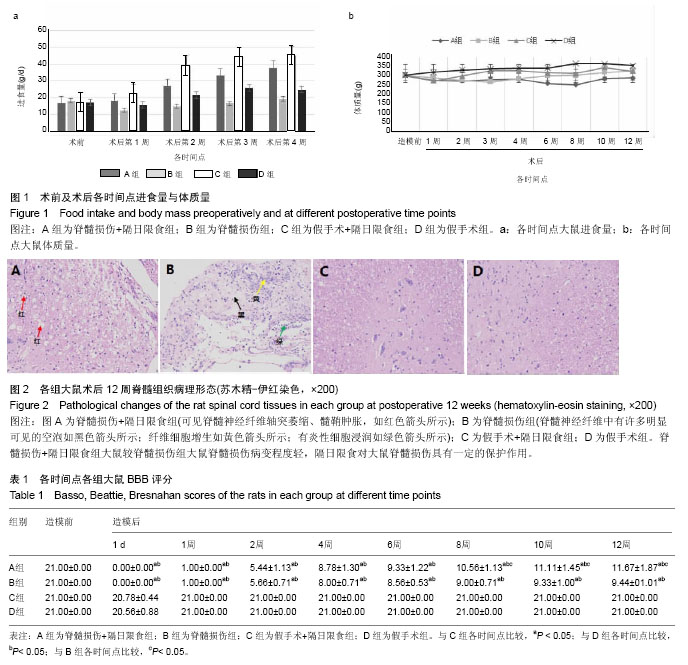| [1] Lee BB, Cripps RA, Fitzharris M,et al. The global map for traumatic spinal cord injury epidemiology: update 2011, global incidence rate.Spinal Cord.2014;52(2):110-116.
[2] 吴周睿,朱元贵,程黎明,等.脊髓损伤与修复的关键科学问题[J].中国科学基金,2013,3:137-153.
[3] Colman RJ, Anderson RM, Johnson SC, et al. Dietary restriction delays disease onset and mortality in rhesus monkeys. Science.2009;325(5937): 201-204.
[4] McCay CM, Maynard LA, Sperling G, et al. Retarded growth, lifespan, ultimate body size and age changes in the albino rat after feeding diets restricted in calories. J Nutr. 1939; 18(1):13.
[5] Martin B, Mattson MP, Maudsley S. Caloric restriction and intermittent fasting: two potential diets for successful brain aging. Ageing Res Rev. 2006;5(3):332-353.
[6] Meyer TE, Kovacs SJ, Ehsani AA, et al. Long-term caloric restriction ameliorates the decline in diastolic function in humans. J Am Coll Cardiol. 2006;47(2):398-402.
[7] Yu ZF, Mattson MP. Dietary restriction and 2-deoxyglucose administration reduce focal ischemic brain damage and improve behavioral outcome: evidence for a preconditioning mechanism. J Neuroscience Res.1999; 57:830-839.
[8] Vasudevan AR, Wu H, Xydakis AM, et al. Eotaxin and obesity. J Clin Endocrinol Metab.2006; 91:256-261.
[9] Colombo M, Kruhoeffer M, Gregersen S, et al. Energy restriction prevents the development of type 2 diabetes in Zucker diabetic fatty rats: coordinated patterns of gene expression for energy metabolism in insulin-sensitive tissues and pancreatic islets determined by oligonucleotide microarray analysis. Metabolism. 2006;55(1):43-52.
[10] Patel NV,Gordon MN,Connor KE,et al.Caloric restriction attenuates Abeta-deposition in Alzheimer transgenic models. Neurobiol Aging. 2005;26(7):995-1000.
[11] Qin W,Yang T,Ho L,et al. Neuronal SIRT1 activation as a novel mechanism underlying the prevention of Alzheimer disease amyloid neuropathology by calorie restriction. J Biological Chemistry.2006; 281:21745-21754.
[12] Wang J,Ho L,Qin W,et al.Caloric restriction attenuates beta-amyloid neuropathology in a mouse model of Alzheimer's disease.J Faseb.2005; 19:659-661.
[13] 侯亚萍. 热量限制及其对阿尔茨海默等退行性疾病的可能作用[J]. 解剖学研究, 2010, 32:52-58.
[14] Varady KA, Hellerstein MK. Alternate-day fasting and chronic disease prevention: a review of human and animal trials. Am J Clin Nutr.2007;86:7-13.
[15] Anson RM, Guo Z, de Cabo R, et al. Intermittent fasting dissociates beneficial effects of dietary restriction on glucose metabolism and neuronal resistance to injury from calorie intake. Proc Natl Acad Sci USA.2003;100:6216-6220.
[16] Bsso DM,Beattie MS,Bresnahan JC.A sensitive and reliable locomotor rating scale for open field testing in rats.J Neurotrauma.1995;12(01):1-21.
[17] Hall ED, Springer JE. Neuroprotection and acute spinal cord injury: a reappraisal. NeuroRx .2004;(1):80-100.
[18] Dumont RJ, Okonkwo DO, Verma S, et al. Acute spinal cord injury, part I: pathophysiologic mechanisms. Clin Neuropharmacol.2001;24(5): 254-264.
[19] Carlson GD, Gorden C. Current developments in spinal cord injury research. Spine J.2002;2(2):116-128.
[20] 席悦.利用微阵列芯片技术探究脊髓损伤的分子机制[J]. 中国组织工程研究,2013,17(24):4529-4538.
[21] Ramer LM, Ramer MS, Bradbury EJ. Restoring function after spinal cord injury: towards clinical translation of experimental strategies. The Lancet Neurology. 2014;13(12):1241-1256.
[22] Colman RJ, Anderson RM, Johnson SC, et al. Caloric restriction delays disease onset and mortality in rhesus monkeys. Science.2009;325: 201-204.
[23] Vermeij WP, Dollé ME, Reiling E, et al. Restricted diet delays accelerated ageing and genomic stress in DNA-repair-deficient mice. Nature.2016;537(7620): 427-431.
[24] Mattison JA, Colman RJ, Beasley TM, et al. Caloric restriction improves health and survival of rhesus monkeys. Nat Commun. 2017;8:14063.
[25] Cheng CW, Villani V, Buono R, et al. Fasting-Mimicking Diet Promotes Ngn3-Driven β-Cell Regeneration to Reverse Diabetes.Cell.2017;168(5):775-788.
[26] Michalsen A, Li C.Fasting Therapy for Treating and Preventing Disease Current State of Evidence. Forsch Komplementmed. 2013;20(6):444-453.
[27] Khaleghi Ghadiri M, Tutam Y, Wassmann H,et al.Periodic fasting alters neuronal excitability in rat neocortical and hippocampal tissues. Neurobiol Dis. 2009;36(2):384-392.
[28] Fann DY, Santro T, Manzanero S, et al. Intermittent fasting attenuates inflammasome activity in ischemic stroke. Exp Neurol. 2014;257:114-119.
[29] Manzanero S, Erion JR, Santro T, et al.Intermittent fasting attenuates increases in neurogenesis after ischemia and reperfusion and improves recovery. J Cereb Blood Flow Metab. 2014;34(5):897-905 .
[30] Laurie M. Davis, James R. Pauly, Ryan D. Readnower, et al. Fasting Is Neuroprotective Following Traumatic Brain Injury. J Neurosci Res.2008;86:1812-1822.
[31] Arumugam TV, Phillips TM, Cheng A, et al. Age and energy intake interact to modify cell stress pathways and stroke outcome. Ann Neurol.2010;67(1): 41-52.
[32] Jeong JH, Yu KS, Bak DH, et al. Intermittent fasting is neuroprotective in focal cerebral ischemia by minimizing autophagic flux disturbance and inhibiting apoptosis. Exp Ther Med.2016;12(5): 3021-3028.
[33] Jeong MA, Plunet W, Streijger F, et al. Intermittent fasting improves functional recovery after rat thoracic contusion spinal cord injury. J Neurotrauma.2011;28: 479-492.
[34] 刘捷. 饮食干预疗法对急性脊髓损伤治疗作用的研究[J]. 中国骨科临床与基础研究杂志, 2012, 4(1): 75.
[35] Plunet WT, Streijger F, Lam CK, et al. Dietary restriction started after spinal cord injury improves functional recovery. Exp Neurol.2008;213(1): 28-35.
[36] Plunet WT,Lam CK,Lee JH,et al.Prophylactic dietary restriction may promote functional recovery and increase lifespan after spinal cord injury. Ann NY Acad Sci.2010;1198 Suppl 1: E1-11.
[37] 刘建成,王文春,罗少杰,等. 隔日限食疗法对大鼠急性脊髓损伤后血清TNF-α的影响[J]. 康复学报,2015,25(4):14-17.
[38] 刘建成. 隔日限食疗法对大鼠急性脊髓损伤后神经保护作用的机制研究[D]. 成都:成都中医药大学,2015. |

